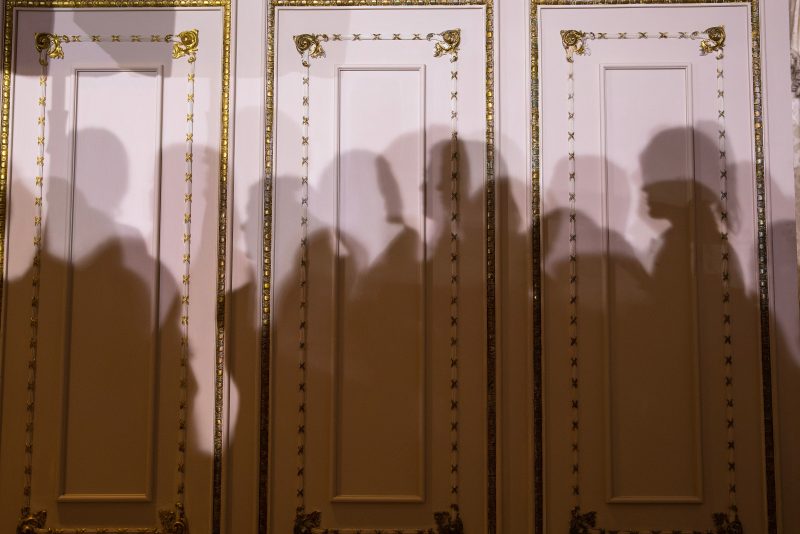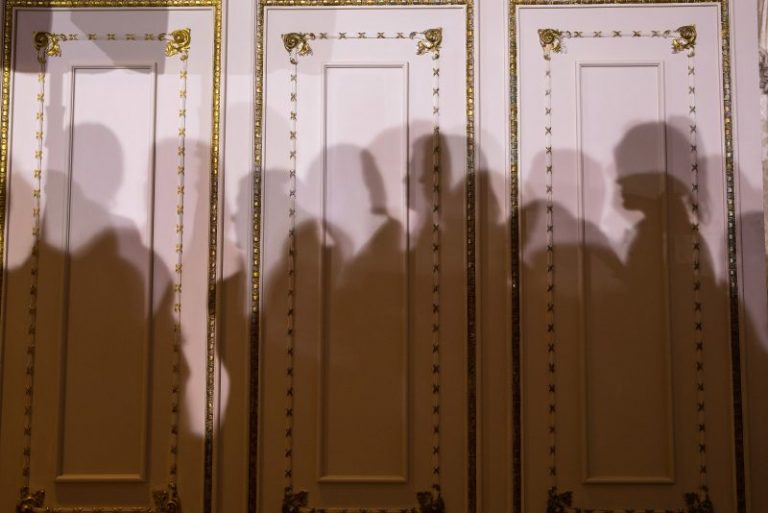
Text messages. Phone records. Photos.
The 37-count federal indictment of former president Donald Trump unsealed Friday provides a vivid account of Trump’s actions at his homes in South Florida and New Jersey, and is based on information from a coterie of close aides, household staffers and lawyers hired to serve Trump in his post-presidency.
The account from Trump insiders in the 49-page indictment provides a thorough rebuttal to many claims made by Trump about his handling of classified material, including that he may have kept some material by accident or may have considered the material declassified by him.
A secretary — identified in the indictment as “Trump Employee 2” — told prosecutors that Trump himself had been packing and looking through boxes, contrary to assertions from his own lawyers. A young political aide, referred to as “the PAC representative” in the indictment, told prosecutors that Trump showed him a classified map about a military operation in a foreign country and told him to stand back because it was a secret document. At a recent CNN town hall, Trump said he did not remember doing such a thing.
Key parts of the indictment are based on one of his lawyer’s detailed notes about Trump’s wishing to obstruct justice by not responding to a subpoena — contradicting the 45th president’s claims that he was always cooperative with the Justice Department and the National Archives and Records Administration. And Trump’s valet was indicted alongside him, after prosecutors obtained the aide’s text messages and accused him of lying about moving boxes at Trump’s request.
Over a lengthy investigation, special counsel Jack Smith and his team interviewed dozens of Trump’s staffers, including his secretary, groundskeepers and political aides. The interviews gave Smith a close-up look at how Trump had structured his unorthodox post-presidential life — and made Trump and his advisers deeply angry and uncomfortable, according to people familiar with the matter, who, like others interviewed for this story, spoke on the condition of anonymity to discuss sensitive topics or the ongoing criminal investigation.
Trump never spoke to prosecutors in the case, but his actions, idiosyncrasies and thoughts were relayed in documents and text messages provided by staffers. Many accounts were provided reluctantly under subpoena, people familiar with those exchanges have said. Other aides’ phones were seized, giving prosecutors access to texts, photos and more.
Security video footage also was taken from Mar-a-Lago, Trump’s Florida home and private club, showing the movements of boxes after prosecutors sent a subpoena demanding the return of documents marked classified. Photos in the indictment show Trump’s bathroom, complete with a dangling chandelier, where he stored dozens of boxes of documents. Additional photos show other places where documents were stored, including his ballroom and a storage room.
Phone records detailed calls between Trump and his valet that coincided with boxes being moved.
Some of the most compelling testimony comes from people who were hired to help Trump.
Evan Corcoran, a lawyer brought onto Trump’s staff in 2022, is the person described as “Attorney 1” in the indictment, according to a person familiar with the situation. Corcoran, a Maryland lawyer, was a former U.S. attorney who represented Trump ally Stephen K. Bannon in the past and was introduced to Trump by Trump’s longtime aide and legal adviser Boris Epshteyn.
Corcoran fought vigorously against testifying in court, citing attorney-client privilege, but was compelled by a judge, who said prosecutors were entitled to Corcoran’s notes and recollections about conversations with Trump because the exchanges may have taken place in furtherance of a criminal act — in this case, withholding documents and deceiving the government.
His testimony rattled Trump.
Through his own lawyer, Corcoran declined to comment.
On the day Trump’s attorneys returned documents to the Justice Department in response to the grand jury subpoena, Trump told Corcoran to search through the material in a folder and indicated that he should remove any problematic documents before handing the folder over, the indictment alleges.
Corcoran provided a detailed summary of Trump’s comments that indicate he was looking to avoid returning documents. In Corcoran’s telling, Trump was determined to keep the boxes even though he knew he had received a grand jury subpoena.
“I really don’t want anybody looking through my boxes, I really don’t, I don’t want you looking through my boxes,” he said, according to Corcoran.
He allegedly also said: “Well, what if we, what happens if we just don’t respond at all or don’t play ball with them?” and “Wouldn’t it be better if we just told them we don’t have anything there?”
Information prosecutors appear to have obtained from Corcoran also indicates that Trump repeatedly claimed that a lawyer for Hillary Clinton, his 2016 presidential rival, had taken the blame for Clinton’s misuse of emails, and he allegedly said the lawyer’s willingness to do so was a trait he admired.
Another key aide, described in the indictment as “Trump Employee 2,” matches information confirmed to The Washington Post about former Trump executive assistant Molly Michael. Michael and a lawyer representing her did not respond to requests for comment.
Michael sat outside Trump’s office, connected his calls, kept his schedule and often translated his moods to visitors and other Trump advisers. She was deeply involved in all aspects of his life, Trump advisers said, until she left his employ last year. Michael was rattled by the extensive attention from federal authorities conducting the investigation, people familiar with the situation have said.
Michael provided text messages and photos to federal investigators, the indictment shows, and kept close tabs on Trump’s packing of boxes himself — contrary to the claims made by some of his lawyers.
“Box answer will be wrenched out of him by tomorrow,” Michael said in a text message to Alex Cannon, a Trump lawyer trying to get him to return materials to the Archives. Cannon is referred to in the indictment as a “Trump Representative,” according to a person familiar with the situation. He declined to comment.
At another time, Michael updates another Trump aide on the former president’s efforts to sort through boxes and is said in the indictment to help Trump valet Walt Nauta move boxes. Her text messages appear frequently throughout the indictment, often in exchanges with Nauta.
Nauta was charged alongside Trump, but Michael was not, and people familiar with the matter have said she cooperated with the Justice Department. Nauta, on the other hand, is accused of lying during the investigation.
As Trump tried to avoid complying with a May 11, 2022, subpoena that required him to produce all documents with classification markings that were in his possession, Nauta was the person he relied on to help conceal the boxes he wanted to keep, the indictment alleges.
In the time between the issuing of the subpoena and Trump’s attorney’s review of boxes in the storage room on June 2, 2022, to find documents being sought, Nauta moved approximately 64 boxes to Trump’s residence at Trump’s request, according to the indictment.
The indictment shows the valet’s movements — along with phone calls he received from Trump.
On the afternoon of May 22, 2022, it says, Nauta entered the storage room and emerged 34 minutes later carrying one of Trump’s boxes. On May 24, 2022, “between 5:30 p.m. and 5:38 p.m., Nauta removed three boxes from the Storage Room” at Trump’s direction, the indictment reads.
A few days passed, and on May 30, 2022, after a 30-second phone call with Trump, Nauta removed 50 boxes from the storage room, according to the indictment. Later that day, a member of Trump’s family texted Nauta that the person had seen that he put boxes in Trump’s room.
“I think he wanted to pick from them,” Nauta wrote to the “Trump family member” in a text message obtained by prosecutors. The indictment does not identify the family member, but it would be a woman who has access to Trump’s private quarters at Mar-a-Lago.
“He told me to put them in the room and he was going to talk to you about them,” Nauta writes, after the “family member” says there will not be room for the boxes to go on the plane to Trump’s home in Bedminster, N.J., because the aircraft will be “full with luggage.”
On June 1, 2022, at 12:52 p.m., Nauta visited the storage room once again and removed 11 boxes, the indictment says.
Nauta made one more trip before Trump’s attorney arrived on June 2, 2022, to review the boxes in the storage room. After Trump and Nauta spoke on the phone at 9:29 a.m. that day, according to the indictment, Nauta, along with another club employee, moved 30 boxes from Trump’s residence back to the storage room.
The government alleges that Nauta lied in an interview with the FBI about moving boxes.
“Are you aware of any boxes being brought to his home — his suite?” the FBI agent asks.
Nauta responds decisively: “No.”
A lawyer for Nauta did not respond to a request for comment.
In two other instances in the indictment, unidentified Trump aides witness the former president’s mishandling of classified information. At Bedminster in 2021, the indictment says, Trump showed a picture of a classified map related to a military operation of another country to an unidentified aide working for his political action committee.
Trump “told the PAC representative that he should not be showing the map to the PAC representative and to not get too close,” the indictment says.
A recording mentioned in the indictment describes a different meeting at Bedminster during which the former president talks about knowing a document related to Iran is classified. “See as president I could have declassified it,” he says to an unidentified staffer.
“Now I can’t you know,” he says.
“Now we have a problem,” the unknown staffer says.
“Isn’t that interesting?” Trump responds.


Comments are closed.